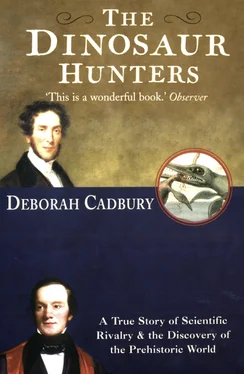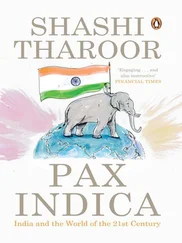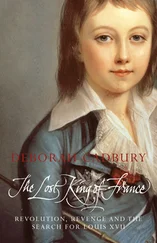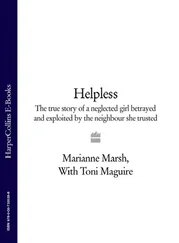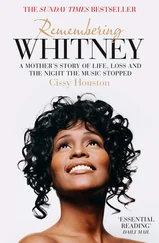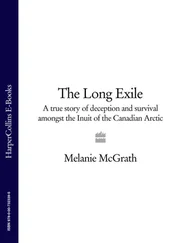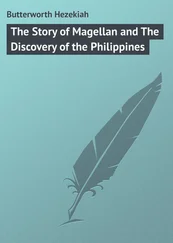Even more puzzling was the second set of teeth in his collection, the herbivorous teeth found by his wife. These ‘possessed characters so remarkable that the most superficial observer would have been struck with their appearance as something novel and interesting,’ he wrote. ‘When perfect they must have been of a very considerable size.’ Self-taught, without the backing of a university or membership of a prestigious society, Mantell could hardly claim that these once belonged to a giant herbivorous lizard when such an improbable creature was not supposed to have existed. He might just as well suggest he had found a centaur, a unicorn or a dragon, or some other preposterous creature of ancient myth.
But the most remarkable feature of all was the sheer size of the beasts. Some of the fragments of vertebrae were up to five inches long; there was a part of a rib that measured twenty-one inches long, even the metatarsal bones in the foot were huge and chunky. As he was chiselling away one night, he realised that one particular broken section of thigh bone emerging from the stone indicated an animal far larger than any he knew – this piece was nearly 30 inches long and 25 inches in circumference. There it lay in front of him, defying all logic and reason. There was no way of proving to which set of teeth it belonged. Compared to a mammal bone, if scaled up in size his discovery would make a preposterous animal, far larger even than a house.
I may be accused of indulging in the marvellous, if I venture to state that upon comparing the larger bones of the Sussex lizard with those of the elephant, there seems reason to suppose that the former must have more than equalled the latter in bulk and have exceeded thirty feet in length! And yet some bones in my possession warrant such a conclusion … this species exceeded in magnitude every animal of the lizard tribe hitherto discovered, either in a recent or a fossilised state.
Could a heart really pump blood around a creature 30–40 feet long? Would muscles be strong enough to support such a heavy frame? What would it have eaten to keep its several tons of reptile flesh in pristine vigour? The creature beginning to emerge from his solitary work each night was hardly believable, a phantom from the underworld, yet there it was, solid as a rock, unassailable. As a glimpse of an ancient form of life it was tantalising; a seemingly endless, uncompletable, jigsaw. None of it added up to a whole animal, or even a coherent view of part of an animal. But with single-minded, purposeful dedication, Mantell continued to devote all his spare time to trying to solve the mystery. Everything in his life was sacrificed to this one bewitching interest. He would place the bones in history. He would be the man acclaimed.
But unknown to Gideon Mantell, he was not the only person in England in the early 1820s who had uncovered evidence that giant lizards once roamed the land.
3 Toast of Mice and Crocodiles for Tea
Here we see the wrecks of beasts and fishes
With broken saucers, cups and dishes …
Skins wanting bones, bones wanting skins
And various blocks to break your shins.
No place in this for cutting capers,
Midst jumbled stones and books and papers,
Stuffed birds, portfolios, packing cases
And founders fallen upon their faces …
The sage amidst the chaos stands,
Contemplative with laden hands,
This, grasping tight his bread and butter
And that a flint, whilst he doth utter
Strange sentences that seem to say
‘I see it all as clear as day.’
‘A Picture of the Comforts of Professor
Buckland’s rooms in Christ Church,
Oxford’ by Philip Duncan, 1821, cited in
The Life and Correspondence of WilliamBuckland by Anna Gordon, 1894
In the heart of Oxford, under the watchful eye of the deans and canons at the university, the Reverend William Buckland’s enthusiasm for ‘undergroundology’ was beginning to attract wider support. As Reader in Mineralogy he had expanded the course to debate the latest geological ideas: whether the ‘days’ of Creation could correspond to lengthy ‘eras’; the nature of Noah’s Flood; the order of Creation. According to one reviewer, Buckland was so inspiring as a speaker that ‘he awakened in the University and elsewhere, an admiration and interest in Geology’. He told his friend the amateur geologist Lady Mary Cole that he had been lecturing to an ‘overflowing class … amongst whom I reckon the Bishop of Oxford, four other Heads of Colleges and three Canons of Christchurch’.
His idiosyncrasies were becoming almost as famous as his lectures and were accepted at the university as part of his brilliance. Anyone passing through the neatly trimmed rose gardens of the quad at Corpus Christi to Buckland’s rooms, expecting to find the usual happy amalgamation of elegance and learning fitting for a don, would soon discover that the professor had different priorities. ‘I can never forget the scene that awaited me on repairing from the Star Inn to Buckland’s domicile,’ recalled Roderick Murchison, an undergraduate at Oxford. ‘Having climbed up a narrow staircase … I entered a long corridor-like room filled with rocks, shells and bones in dire confusion. In a sort of sanctum at the end was my friend in his black gown, looking like a necromancer, sitting on a rickety chair covered with some fossils, clearing out a fossil bone from the matrix.’
In addition to fossils strewn liberally on almost every surface and the stuffed creatures in the hall, Professor Buckland was a keen naturalist and kept a number of unusual pets. There were cages full of snakes and green frogs in the dining-room, where the candles were placed in Ichthyosauri’s vertebrae. Guinea-pigs roamed freely throughout his office. Walter Stanhope, a tutor at Oxford, described an evening in Buckland’s apartments: ‘I took care to tuck up my legs on the sofa, for fear of a casual bite from a jackal that was wandering around the room. After a while I heard the animal munching up something under the sofa and was relieved that he should have found something to occupy him. I told Buckland. “My poor guinea pigs!” he exclaimed, and sure enough, four of the five of them had perished.’
By far the most splendid creature in Buckland’s menagerie was a bear, rather grandly named Tiglath Pileser, after the founder of the Assyrian Empire in the Old Testament Book of Kings. Unlike his namesake, who was renowned for his brutal punishment of his opponents, Tiglath the bear was ‘tame and caressing’. Buckland even went so far as to provide the bear with a student costume in which he participated fully in university life, especially the wine parties. ‘We had an immense party at the Botanic Gardens,’ Charles Lyell, one of Buckland’s undergraduates, recalled. ‘Young Buckland had a bear, “Tig” dressed up as a student complete with cap and gown.’ Tiglath Pileser was formally introduced to senior figures at the university. ‘It was diverting to see two or three of the dons not knowing what to do for fear their dignity was compromised.’
Most perplexing of all for visitors to Buckland’s apartments was the menu, since Buckland, a born experimentalist, had decided to eat his way through the animal kingdom as well as study it. ‘I recollect various queer dishes which he had at his table,’ recalled his friend John Playfair. ‘The hedgehog was a good experiment and both Liebig and I thought it good and tender. On another occasion I recollect a dish of crocodile, which was an utter failure … though the philosophers took one mouthful, they could not be persuaded to swallow it and rejected the morsel with strong language.’ John Ruskin, recalling his undergraduate days at Buckland’s table, wrote: ‘I met the leading scientific men of the day, from Herschel downwards … Everyone was at ease and amused at that breakfast table, the menu and the science of it, usually in themselves interesting. I have always regretted a day of unlucky engagement on which I missed a delicate toast of mice.’
Читать дальше
